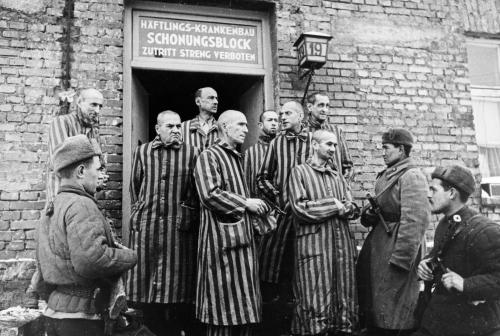Concentration camp SUBCAMP AUSCHWITZ toilet wall sign LATRINE
Concentration camp SUBCAMP AUSCHWITZ toilet wall sign LATRINE
Product
Concentration camp SUBCAMP AUSCHWITZ toilet wall sign LATRINE
found on site
Empty

In the course of the war, the camp was staffed by 6,500 to 7,000 members of the German Schutzstaffel (SS), approximately 15 percent of whom were later convicted of war crimes. Some, including camp commandant Rudolf Höss, were executed. The Allied Powers refused to believe early reports of the atrocities at the camp, and their failure to bomb the camp or its railways remains controversial. One hundred and forty-four prisoners are known to have escaped from Auschwitz successfully, and on October 7, 1944, two Sonderkommando units—prisoners assigned to staff the gas chambers—launched a brief, unsuccessful uprising.
As Soviet troops approached Auschwitz in January 1945, most of its population was evacuated and sent on a death march. The prisoners remaining at the camp were liberated on January 27, 1945, a day now commemorated as International Holocaust Remembrance Day. In the following decades, survivors such as Primo Levi,Viktor Frankl, and Elie Wiesel wrote memoirs of their experiences in Auschwitz, and the camp became a dominant symbol of the Holocaust. In 1947, Poland founded a museum on the site of Auschwitz I and II, and in 1979, it was named a UNESCO World Heritage Site.
The ideology of Nazism brought together elements of antisemitism, racial hygiene, and eugenics, and combined them with pan-Germanism and territorial expansionism with the goal of obtaining more Lebensraum (living space) for the Germanic people.[10] Nazi Germany attempted to obtain this new territory by attacking Poland and the Soviet Union, intending to deport or kill the Jews and Slavs living there, who were viewed as being inferior to the Aryan master race.[11] After the invasion of Poland in September 1939,
German dictator Adolf Hitler ordered that the Polish leadership and intelligentsia should be destroyed.[12] Approximately 65,000 civilians were killed by the end of 1939. In addition to leaders of Polish society, the Nazis killed Jews, prostitutes, Romani, and the mentally ill.[13][14] SS-Obergruppenführer (Senior Group Leader) Reinhard Heydrich, then head of the Gestapo, ordered on September 21 that Jews should be rounded up and concentrated into cities with good rail links. Initially the intention was to deport the Jews to points further east, or possibly to Madagascar.[15]
Concentration camp SUBCAMP AUSCHWITZ toilet wall sign LATRINE
found on site
UNIQUE Czech political prisoner survivor AUSCHWITZ and 3 other concentation camp red triangle patch and document
fully researched, see last paper
a unique and amazing piece of holocaust history !
Concentration Camp AUSCHWITZ Old wooden hand prosthesis Inmate Holocaust
Right after the war, the residents of the town of Oświęcim took various things from there
they still have a lot of memorabilia in their homes. that's a fact.
this was sold from a resident to my friend's antique store in the city.
100% provenance
Concentration Camp AUSCHWITZ SCARCE RM .50 money token for WAFFEN SS TOTENKOPF GUARDS
stamped, extremely rare
in exc condition sold over 1200$
Concentration Camp AUSCHWITZ BIRKENAU original photo taken at the liberation NEW train arrival GHETTO DEPORTED JEWISH GYPSIES
i have a lot of 13 original photos taken at the liberation.
they are written on the back and dated 1947, date when they were stored to archive by the military.
18x13cm
amazing piece of holocaust history !
Concentration Camp AUSCHWITZ BIRKENAU original photo taken at the liberation
i have a lot of 13 original photos taken at the liberation.
they are written on the back and dated 1947, date when they were stored to archive by the military.
18x13cm
amazing piece of holocaust history !
UNIQUE survivor HAND MADE painting of AUSCHWITZ BIRKENAU concentration camp MUSEUM PIECE!
large size frame.
signed
this is a museum piece !
unique and amazing for a HOLOCAUST display !
NOT INTENTED other to preserve history or to teach the Holocaust.
AUSCHWITZ III MONOWITZ IG FARBEN INDUSTRY BAYER PENNANT FLAG FORCED LABOR inmate
Concentration camp AUSCHWITZ feldpost letter enveloppe sent to GENERALGOVERNMENT
enveloppe only
SCARCE Czech ZYKLON-B GAS FILTER AND MASK concentration camps KL KZ
Czech gas mask and a German-made filter used to protect the user from the effects of Zyklon-B, the cyanide-based pesticide used to exterminate millions in the Nazi German concentration camps of World War II. The 5" gray painted filter bears a paper label: "Use for Zyklon" with the red letter "J" and an expiration date of June 1943.
The Czech republic produced ZYKLON B during the WW2 for the Germans. The factory was Draslovka Kolín a.s..
A museum piece.
NOTE : THAT ITEM WONT BE SOLD TO ANYONE - NO NAZY, PARTISANS OR ANY PEOPLE WITH MENTAL PROBLEMS OR BAD INTENTIONS WILL BUY THIS.
Only collectors for history and preservation or museums will be allowed to buy this.